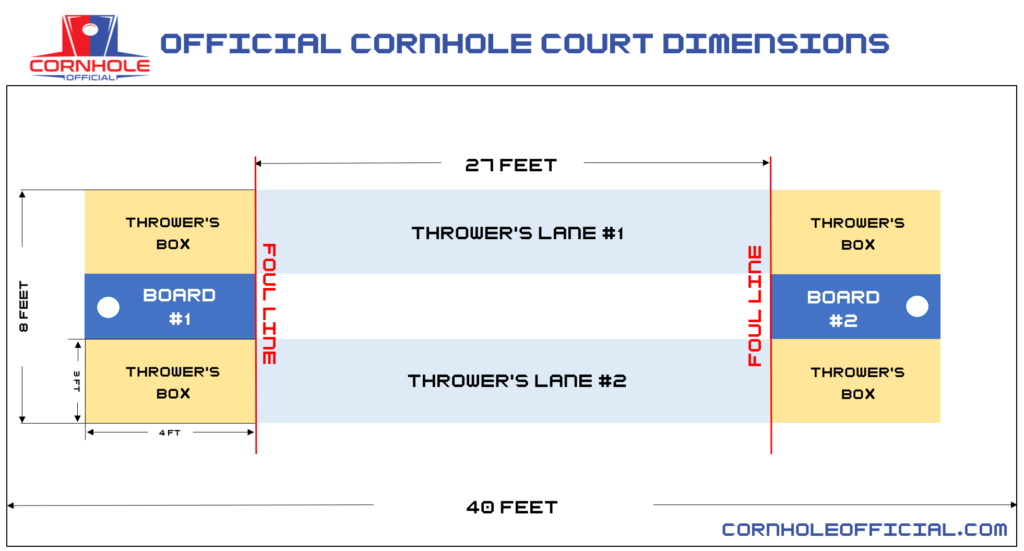What Is Regulation Corn Board Hole Dimensions
Regulation cornhole has become a popular game for outdoor gatherings, tailgating events, and backyard parties. To enjoy this game to the fullest, it's important to have cornhole boards with the right dimensions. In this post, we will dive into the details of regulation cornhole board dimensions, providing you with all the information you need to know.
1. What are the Regulation Corn Board Hole Dimensions?
Regulation corn boards are rectangular platforms with a hole at one end. The size of the board and the hole are crucial to the game's rules and overall playing experience.
The American Cornhole Association (ACA) defines the standard dimensions for regulation corn boards. According to their guidelines, a regulation corn board should have the following specifications:
- Length: 48 inches
- Width: 24 inches
- Thickness: 1/2 inch to 3/4 inch
- Top and Side Board Material: Plywood or another suitable material
The hole on a regulation corn board is located towards the top end of the board, centered horizontally and 9 inches from the top. The hole measures 6 inches in diameter. It's crucial to maintain these dimensions for a fair and consistent gameplay experience.
2. Choosing the Right Cornhole Board
When looking for cornhole boards, it's important to ensure that they meet the regulation dimensions mentioned above. While there are many options available in the market, not all boards may adhere to the official specifications. Here are some factors to consider when choosing the right cornhole board:
2.1. Material
Cornhole boards can be made from various materials, such as plywood, plastic, or composite materials. Plywood is the most common material used for regulation corn boards due to its durability and affordability.
While plastic boards may be more weather-resistant, they often lack the same level of quality and performance as plywood. Composite boards offer a good balance between durability and weather-resistance, but they may come at a higher price.
2.2. Construction
The construction of the cornhole board is another important factor to consider. Regulation boards typically have a solid frame and a sturdy top surface. Mitered or braced corners help maintain the board's integrity and prevent warping.
Ensure that the board is made with high-quality materials and sturdy craftsmanship to withstand outdoor use and provide a consistent playing surface.
2.3. Finish and Design
Cornhole boards come in various finishes and designs, allowing you to choose one that matches your style and preferences. However, it's important to prioritize functionality over aesthetics.
A smooth surface with a consistent finish is crucial for the bean bags to slide easily and for accurate gameplay. Look for boards with a high-gloss, water-resistant finish that ensures durability while maintaining the required surface smoothness.
3. Frequently Asked Questions (FAQs)
3.1. Are there any regulations for the bean bags used in cornhole?
While there are no specific regulations for bean bags in official cornhole gameplay, there are some accepted standards. The American Cornhole Association recommends using bean bags made of durable fabric, filled with corn feed, and weighing approximately 15 to 16 ounces.
However, casual players often use bean bags filled with synthetic materials or plastic pellets, as they tend to be more weather-resistant and may last longer.
3.2. Can I customize my cornhole board?
Yes, you can customize your cornhole board according to your preferences. Many enthusiasts enjoy painting custom designs or team logos on their boards. However, it's important to ensure that the board's surface remains smooth and consistent with the required finish. Any modifications should not alter the dimensions or affect gameplay.
3.3. Are the regulations the same for cornhole games played casually?
While official regulations are meant for competitive and organized gameplay, casual players may have different preferences and variations. As long as all players agree on the dimensions and rules before the game, you can modify the regulations to suit your needs. However, sticking to the official regulations ensures consistency and fair gameplay.
In conclusion, understanding the regulation corn board hole dimensions is crucial for a fair and enjoyable game of cornhole. By choosing the right cornhole boards that meet these standards, you can ensure a consistent playing experience. Remember to always prioritize functionality and quality when selecting cornhole boards for your backyard gatherings and outdoor events.
How To Play Cornhole - Official Rules And Regulations
 Image Source : cornholeofficial.com
Image Source : cornholeofficial.com Build Dimensions
Cornhole Measurement | Corn Hole Plans, Cornhole, Cornhole Rules
 Image Source : www.pinterest.com.mx
Image Source : www.pinterest.com.mx Cornhole Boards | Platforms | Cornhole Board Dimensions, Diy Cornhole
 Image Source : www.pinterest.de
Image Source : www.pinterest.de cornhole platforms woodshop
How To Build A Cornhole Board Set - Chuggles Cornhole Decals | Corn
 Image Source : www.pinterest.com
Image Source : www.pinterest.com cornhole game games board build corn boards diy hole set building plans backyard make outdoor instructions designs decals dimensions lawn
Pin On Backyard Games
 Image Source : www.pinterest.com.mx
Image Source : www.pinterest.com.mx cornhole regulation corn gargantuan cornholeboards
ACA Regulation Cornhole SIze | Cornhole Boards, Best Cornhole Boards
 Image Source : www.pinterest.com
Image Source : www.pinterest.com board cornhole boards plans corn hole regulation size plan choose aca games
Cornhole | Bean Bag Platforms Dimensions & Drawings | Dimensions.Guide
cornhole dimensions bean bag boards toss regulation platforms hole plan guide standard platform
Cornhole platforms woodshop. How to play cornhole. Cornhole boards. Board cornhole boards plans corn hole regulation size plan choose aca games. Cornhole dimensions bean bag boards toss regulation platforms hole plan guide standard platform